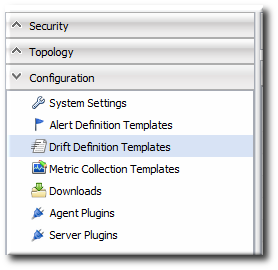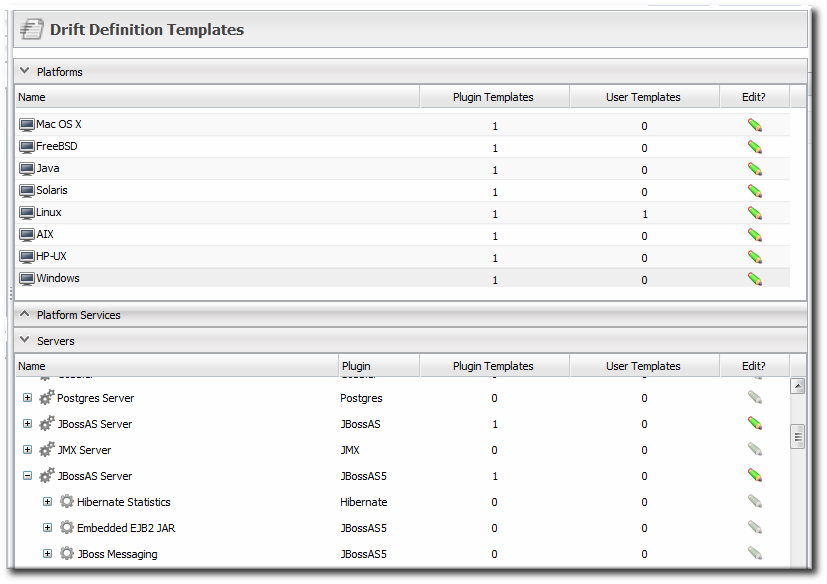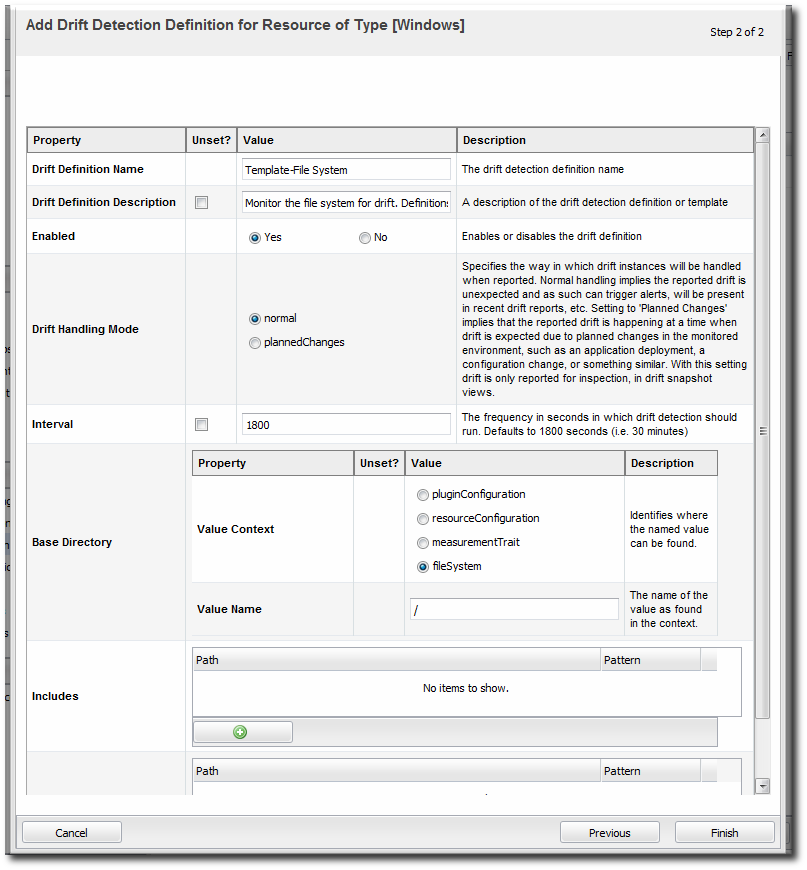15.3. Creating a Drift Definition Template
Every time a new drift definition is created, it is based on an existing template for the resource type. At least one template is defined for resource types (by default, platforms and JBoss application servers) in their resource plug-in. Additional templates can be created by users.
15.3.1. About Resources and Drift Definition Templates
Copy linkLink copied to clipboard!
Resources of the same type frequently need to have the same, or similar, configuration settings. Particularly for an area like configuration drift, consistency is crucial for accurate and timely IT maintenance. JBoss ON allows this consistency using drift definition templates. Much like alert and monitoring templates, drift definition templates are defined for a resource type (regardless of whether any resources of that type actually exist) and can then be applied to specific resources in the inventory.
Drift templates are a little different than other template types in JBoss ON. First, a drift definition template is exactly that — it is an outline of default settings and values to use when creating a resource-level drift definition. It is not automatically applied to resources.
Additionally, there are two types of drift templates: plug-in defined templates and user-defined templates.
At least one drift definition template is actually defined as part of the plug-in for a resource type. Defining a template in the plug-in descriptor is what indicates that a resource type supports drift monitoring. These are plug-in defined templates; these are the default templates.
Having a plug-in defined template is the way that the JBoss ON agent recognizes that a particular resource type supports drift monitoring. So, the plug-in defined template has a dual purpose. It lets JBoss ON know what resource types support drift, and it gives basic input to help administrators start making their own drift definitions.
Example 15.1. A JBoss Server Drift Definition Template
New drift definition templates can be added by administrators, in addition to the plug-in defined template; these are user-defined templates. These templates can reflect the unique infrastructure and application environment.
A resource-level drift definition is always based on a drift template, which provides some default values to the definition during creation. That template can be plug-in defined or user-defined. Resource-level drift definitions do not have to be attached to a template, so they do not have to be changed every time the template changes, but they are always based on an existing template.
There are some things to remember about drift definition templates:
- Drift templates are not automatically applied to a resource, unlike other template types in JBoss ON. Drift templates are used as the basis for creating resource-level definitions.
- Default drift templates are defined for resources as part of their plug-in descriptor. Custom, user-defined templates can be added along with those defaults.
- Every drift definition is based on a template initially, even if that definition is not attached to that template post-creation.
- Snapshots (the file sets associated with drift definitions) always originate on a resource with a drift definition first. For any content to be associate with a template, the resource-level snapshot has to be promoted up to the template. Drift templates do not generate snapshots or files and then push that down to the resource.
15.3.2. Creating a Drift Definition Template
Copy linkLink copied to clipboard!
A drift template creation form is almost identical to a resource-level drift definition, with two exceptions: it cannot be pinned to a snapshot at the time it is created and it cannot be associated with another template. Obviously, a template is not dependent on another template (even though it is created from another template.) Being unable to pin a template to a snapshot is also logical; when a template is created, it is not associated with any resources. So, it is not possible to generate snapshots, which means that there is nothing to pin the template to.
- Click the Administration tab in the top menu.
- Select the Drift Definition Templates menu table on the left.
- Click the pencil icon for the resource type to add the template to. Not all resources support drift, so they cannot be selected.
- Click the at the bottom to add a new template.
- Select the template to use to as the basis for the new template.Plug-in defined templates are defined in the platform and JBoss server resources, as well as any other resource which supports drift monitoring. Additional, user-defined templates can be also be created and applied.
- Give a unique name to the template. The name and the base directory are combined to identify the definition within JBoss ON.
- Define the settings for the definition, like the interval and whether it is enabled by default. The properties are listed in Table 15.3, “Drift Definition Properties”.
- Set the base directory. This is the top-most directory where drift detection is run for the definition, and the scan recourses down.
- Click the button with the green plus (+) sign to add a subdirectory to include or exclude. The directory can be the base directory by specifying a period (.) as the directory. The pattern identifies which files within the directory to recognize by the service, either to explicitly include or explicitly exclude.The filters support Ant-like FilePatterns, using a path and pattern. The patterns support asterisks (*) as wildcards for any number of characters and question marks (?) for single character wild cards. For example,
**/*.confcan be used to include only.conffiles in any subdirectory.



